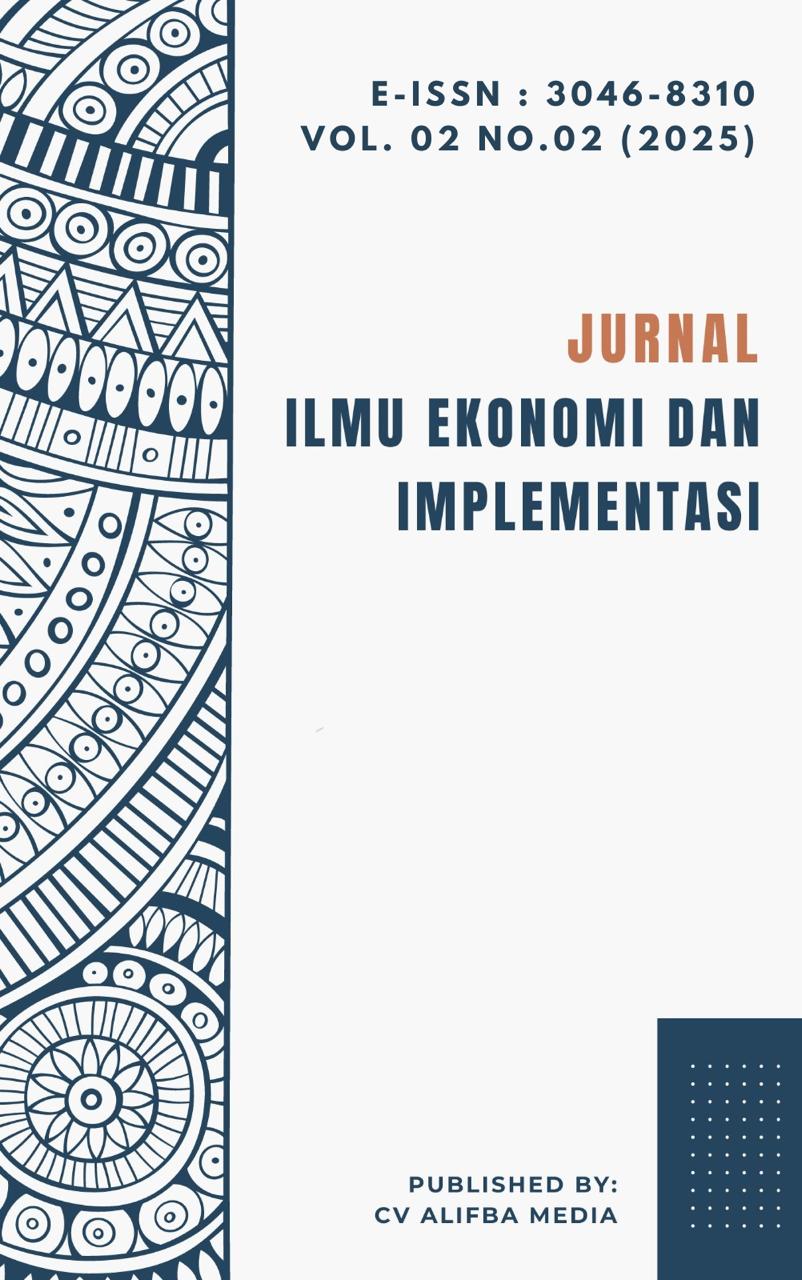The Relevance of Jasser Auda’s Maqasid al-Shariah Perspective in Indonesia’s Infrastructure Development Program
Keywords:
Infrastructure Development, Economic Development, Maqashid al-ShariaAbstract
This study examines the implementation of infrastructure development programs in Indonesia from the perspective of Jasser Auda’s maqashid al-shariah. The research employs a descriptive–qualitative method, utilizing documentation techniques to collect data from various literature sources, including books, journals, documents, and websites. The findings reveal that infrastructure development and economic development in Indonesia are closely interconnected and mutually dependent. Consequently, disparities in infrastructure development can significantly contribute to economic development gaps, which in turn affect the overall welfare of society. From the perspective of Jasser Auda’s maqashid al-shariah: (1) The implementation of infrastructure development in Indonesia has not fully applied the principles of hifz al-mal, hifz al-nasl, and hifz al-nafs, as it still generates social, economic, and environmental issues within communities as a result of ongoing projects; (2) Based on the features of wholeness and purposefulness, the government needs to conduct further evaluation and improvement in the implementation process of infrastructure development by ensuring the harmonization of public rights fulfillment and equitable distribution. This would enable the shared aspirations of both the government and society for inclusive, just, and evenly distributed development to be realized.
References
Afroni Rohim, H. A. (2024). Pembangunan Infrastruktur Dorong Pertumbuhan Ekonomi Indonesia. Kementerian Sekretariat Negara. https://www.setneg.go.id/baca/index/pembangunan_infrastruktur_dorong_pertumbuhan_ekonomi_indonesia
Aisia, G. (2021). Implementasi Program Pengentasan Kemiskinan Ditinjau Dari Maqāṣid Syarī’ah Pada Masyarakat Di Bantaran Kali Code, Kampung Jogoyudan, D.I. Yogyakarta. 2021.
Al-Haj, H., & Ikhsan, I. (2021). Pengaruh Infrastruktur dan Zakat Terhadap Pertumbuhan Ekonomi (Studi Kasus di Kota Banda Aceh). Jurnal Ilmiah Mahasiswa Ekonomi Islam, 3(1), 104–118.
Andrianus, F., & Alfatih, K. (2023). Pengaruh Infrastruktur Terhadap Kemiskinan dengan Menggunakan Data Panel 34 Provinsi di Indonesia. Jurnal Informatika Ekonomi Bisnis, 5(1), 56–62. https://doi.org/10.37034/infeb.v5i1.206
Badan Pusat Statistik. (2021). Statistik Infrastruktur Indonesia 2020: Hasil Pemutakhiran Data Perkembangan Desa 2020. Badan Pusat Statistik Indonesia. https://www.bps.go.id/id/publication/2021/04/28/7ce2f71435c1893e239bf22d/statistik-infrastruktur-indonesia-2020-hasil-pemutakhiran-data-perkembangan-desa-2020-.html
BPS Triwulan II. (2024). Construction Indicators, 2nd Quarter-2024 (Quarter II, Vol. 18, Nomor 4). Badan Pusat Statistik Indonesia. http://scioteca.caf.com/bitstream/handle/123456789/1091/RED2017-Eng-8ene.pdf?
Djumadi, D. (2016). Konsep Pembangunan Ekonomi Persektif Islam. Tahkim, 12(1), 1–16. http://jurnal.iainambon.ac.id/index.php/THK/article/view/25
Fad, M. F. (2019). Kontekstualisasi Maqashid Shari’ah Dalam Sustainable Development Goals. Jurnal Iqtisad: Reconstruction of Justice and Welfare for Indonesia, 6(2), 130–155. https://doi.org/10.31942/iq.v6i2.3142
Fasa, M. I. (2016). Reformasi Pemahaman Teori Maqasid Syariah (Analisis Pendekatan Sistem Jasser Auda). HUNAFA: Jurnal Studia Islamika, 13(2), 218–246. https://doi.org/10.24239/jsi.v13i2.438.218-246
GQII Report. (2023). Global Quality Infrastructure Index Report 2023. https://doi.org/10.13140/RG.2.2.22510.01609
Gultom, R. Z., & Tini, A. Q. (2020). Pembangunan Infrastruktur dalam Islam: Tinjauan Ekonomi dan Sosial. Jurnal Ilmiah Ekonomi Islam, 6(2), 203. https://doi.org/10.29040/jiei.v6i2.912
Gumanti, R. (2018). Maqasid Al-Syariah Menurut Jasser Auda (Pendekatan Sistem dalam Hukum Islam). Jurnal Al-Himayah, 2(1), 97–118.
Hermanto, H., Meiyani, E., & Risfaisal, R. (2019). Persepsi Masyarakat Terhadap Pembangunan Infrastruktur Jalan Tol Layang A.P Pettarani Di Kota Makassar. Equilibrium: Jurnal Pendidikan Sosiologi, 7(1), 198–205. https://doi.org/10.26618/equilibrium.v7i1.2620
Mahri, A. J. W., Cupian, C., Al Arif, M. N. R., Arundina, T., Widiastuti, T., Mubarok, F., Fajri, M., Azizon, A., & Nurasyiah, A. (2021). Pembangunan Ekonomi Islam. In Jurnal Akuntansi, Manajemen, Bisnis dan Teknologi (AMBITEK) (Pertama, Vol. 3, Nomor 2). Departemen Ekonomi dan Keuangan Syariah - Bank Indonesia. https://doi.org/10.56870/ambitek.v3i2.81
Moleong, L. J. (2014). Metode Penelitian Kualitatif Edisi Revisi. PT Remaja Rosdakarya.
Mutholingah, S., & Zamzami, M. R. (2018). Relevansi Pemikiran Maqashid Al-Syariah Jasser Auda Terhadap Sistem Pendidikan Islam Multidisipliner. Journal TA’LIMUNA, 7(2), 90–111. https://doi.org/10.32478/talimuna.v7i2.183
Nainggolan, B., & Soleman, R. (2022). Pembangunan Berwawasan Gender Dalam Pertumbuhan Ekonomi Indonesia Dan Perspektif Maqashid Syariah Jasser Auda. IQTISHADUNA: Jurnal Ilmiah Ekonomi Kita, 11(2), 153–168. https://doi.org/10.46367/iqtishaduna.v11i2.760
Nirmalasari, S. A., & Putri, N. (2022). Peran Perempuan Dalam Meningkatkan Ekonomi Rumah Tangga Perspektif Maqashid Syariah Jasser Auda (Studi Kasus Di Kecamatan Tengaran Kabupaten Semarang). Jurnal Magister Ekonomi Syariah, 1(1), 43–53. https://doi.org/10.14421/jmes.2022.011-04
Pramono, S. A., & Yulianto, P. (2020). Pembangunan Infrastruktur Berwawasan Lingkungan. Teodolita: Media Komunkasi Ilmiah di Bidang Teknik, 21(1), 89–98.
PUPR. (2023). Informasi Statistik Infrastruktur, PUPR 2023. Kementerian Pekerjaan Umum dan Perumahan Rakyat.
Putri, N. E., Helmi, H., Noer, M., & Yossyafra, Y. (2021). Systematic Literature Review (SLR) Dinamika Perencanaan Pembangunan Infrastruktur Berkelanjutan. Jurnal Public Policy, 7(2), 103–111. https://doi.org/10.35308/jpp.v7i2.3811
Rama, A., & Makhlan, M. (2013). Pembangunan Ekonomi dalam Tinjauan Maqashid Syari’ah. Dialog: Jurnal Penelitian dan Kajian Islam, 36(1), 31–46.
Rodzi, M. F. (2023). Pembangunan Infrastruktur Dan Pemerataan Ekonomi Di Indonesia. Jurnal Masyarakat dan Desa, 3(2), 151–163. https://doi.org/10.47431/jmd.v3i2.353
Sinarta, I. N., Wahyuni, P. I., & Mahendrayani, A. I. . (2021). Analisis Ancaman Gerakan Tanah Dan Kerusakan Lingkungan Pada Pembangunan Infrastruktur Shortcut. Konferensi Nasional Teknik Sipil Ke-15 (Konteks-15), 82(1), 1–10.
Sugiyono. (2017). Metode Penelitian Kuantitatif, Kualitatif, dan R&D. Alfabeta.
Susanto, N. (2019). Public (Dis)Engagement in Toll Road Project: A Case Study from Indonesia. JKAP (Jurnal Kebijakan dan Administrasi Publik), 23(1), 77–91. https://doi.org/10.22146/jkap.43994
Todaro, M. P., & Smith, S. C. (2015). Economic Development (Twelfth Ed). Pearson.
Willar, D., Waney, E. V. Y., & Senduk, N. (2019). The Execution of Infrastructure Project Life-Cycle. MATEC Web of Conferences, 258. https://doi.org/10.1051/matecconf/201925802017






